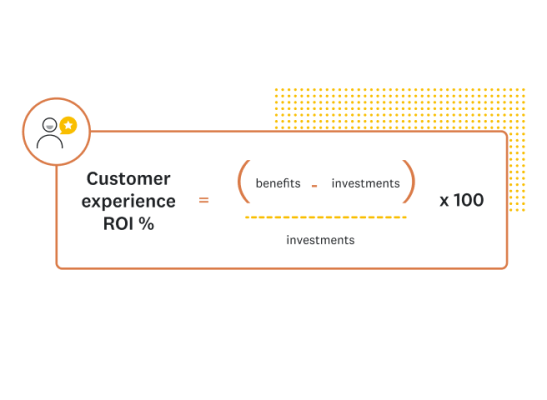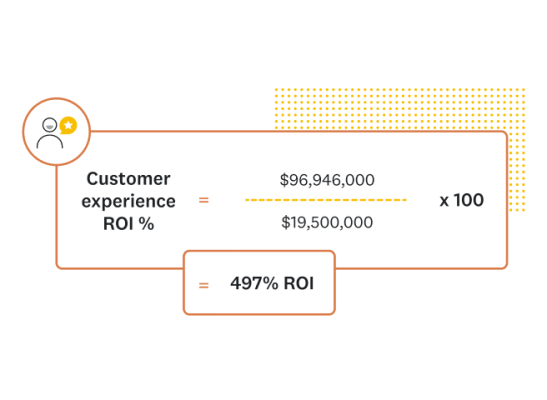How to calculate the ROI of customer experience
How to prove the ROI of your customer experience programs and initiatives.
Most brands agree that excellent customer experiences (CX) are important. However, that doesn’t mean they deliver one.
Before approving any investment into a CX program, organizations will want to see a clear forecast and an estimated return on investment (ROI). It’s not enough to provide soft benefits.
However, proving direct ROI can be complex for a number of reasons:
- The benefits of CX programs can take years to reveal themselves.
- CX is often seen as a quantitative field, making it more challenging to draw quantitative financial outcomes.
- CX improvements often lead to small, holistic improvements to a business. Often, although worthwhile, it's difficult to trace the impact of these smaller changes.
Customer experience leaders need to show the numbers to improve alongside other business programs. This guide will help you do just that.
Step 1: Know the ROI formula for CX
The first step is to become familiar with the formula for calculating the ROI of customer experience.
It’s straightforward:
Customer experience ROI = Return / Investment
For more clarity, you can break the formula down into smaller elements, such as:

Benefits could include customer satisfaction, top-line revenue, customer retention, cost-to-serve, cross-sell and up-sell, etc. Investments could include employee training, new technology, operational costs, and so on.
To better illustrate the process, we’ll use a made-up company named BarkTalk. We like to let our imagination run wild here at SurveyMonkey, so let’s say that BarkTalk is a futuristic tech company that sells a variety of pet gadgets. Their most popular product: is a collar you place around your dog’s neck that translates their barking into your preferred language.
Let’s prove the customer experience ROI at BarkTalk.
Step 2: Calculate the benefits of CX
To calculate the return of your CX program, you need to first calculate your quantitative benefits and investments.
Here is how to calculate return:
Return = Benefit – Investment
Most CX professionals find calculating benefits to be the hardest part of a CX ROI calculation. In order to do so, you need to consider quantitative and qualitative data while also linking customer experiences and business metrics.
On the other hand, calculating the total investment of a CX program is fairly easy.
In this chapter, we’ll dive into the benefit element of this formula using our mock company, BarkTalk. For the sake of this guide, we’ll demonstrate how to calculate results for the business metrics that are most commonly influenced by a great CX program. We’ll then cover the investment element in the next section.
Customer satisfaction
Customer satisfaction often comes from great customer experiences. Satisfaction can go a long way, with a small increase in company CSAT potentially leading to increased trust from customers.
The trick is determining what a one-point increase in your Customer Satisfaction Score (CSAT) is worth in terms of revenue impact. How does a one-point increase in satisfaction influence your customer retention or your upselling?
Here’s one way to quantify the use of CSAT measurement and improvement.
Let’s say that BarkTalk sends out a case-closed CSAT survey to 10,000 customers and receives 1,000 responses. Of those responses, 600 customers scored their experience a 4 or 5. As for the rest, 200 customers scored them a 3 and the remaining 200 scored them a 1 or 2.
BarkTalk can use this data to calculate their CSAT score.
The formula is: (Total 4-5 responses) / (Total responses) x 100 = CSAT score
So, for this case, the math would be: 600 / 1,000 x 100 = 60%
Next, BarkTalk needs to estimate the potential revenue that they can save if they improve their CSAT score by just one point. For the sake of this example, let’s assume the average spend per customer is $500.
The calculation below uses average churn rates that BarkTalk derived by analyzing the relationship between CSAT and customer churn within their business.
| 200 customers who rated 1-2 (92% will churn) | 184 customers will churn |
| 200 customers who rated 3 (80% will churn) | 160 will churn |
| Total revenue lost ($500 x 184 + 160) | $172,000 |
The math above reveals that BarkTalk lost 344 customers. That’s 344 customers who could have returned and, in total, would have spent $172,000 per year.
But let’s say that there is a trend with the customers who rated BarkTalk a 1 or 2. The majority noted in the survey that the customer support service chat took too long to solve an issue.
So BarkTalk takes the necessary measures to optimize their support services. Enough so that when they send out a new CSAT survey, they see a decrease in 1-2 ratings and an increase in 4-5 ratings.
Here are the new scores:
- Total responses: 1,000
- Customers rating 4-5: 700
- Customers rating 3: 200
- Customers rating 1-2: 100
Their CSAT score has increased to 70%.
Let’s apply the same calculation above to the new data to see the impact of a 10% increase in their CSAT score.
| 100 customers who rated 1-2 (92% will churn) | 92 customers will churn |
| 200 customers who rated 3 (80% will churn) | 160 will churn |
| Total revenue lost $500 x (160 + 92) | $126,000 |
| Total revenue they save with a 10% increase | $46,000 ($172,000-$126,000) |
By increasing their CSAT score by just 10%, BarkTalk could have saved $46,000 per year.
Customer retention
There is a clear correlation between positive customer experiences and decreased customer churn. If customers are unhappy with your brand, they’ll most likely switch to one of your competitors. This is even more likely in 2023, with 59% of companies experiencing more competition than last year.
Aside from the obvious revenue impact, companies should care about decreasing churn for two reasons:
- It’s easier to sell to existing customers than to generate new business.
- Loyal customers increase a company’s customer lifetime value (LTV) over time, increasing profits.
So how do you quantify the value of a CX program that decreases churn and boosts customer retention?
Let’s say that BarkTalk wants to increase customer retention by 10% by way of improving customer experience across the organization within two years.
For the sake of simplicity, let’s also assume that BarkTalk will not acquire any new customers in years 1 and 2 of this experiment.
The workflow below shows how to prove that a retention increase of 10% can result in a revenue increase of $60 million for the company.
| Number of customers in year 1 | 1,000,000 |
| Average revenue per customer | $1,000 |
| Retention rate | 60% |
| Number of customers at the start of year 2 (at 60% retention rate) | 600,000 (60% of 1,000,000) |
| Number of customers at the end of year 2 (at 60% retention rate) | 360,000 (60% of 600,000) |
| Number of customers at the end of year 2 if the retention rate increased by 10% | 420,000 (70% of 600,000) |
| Additional revenue in year 2 due to an increase in customer retention | $60,000,000 ($1,000 x (420,000-360,000)) |
For more tactics to improve customer retention, check out this article.
Cross-sell and upsell
Another benefit of great customer experience is you’ll see an increase in cross-selling and upselling. Customers who like your brand will spend more on it.
Upselling refers to encouraging customers to purchase a comparable higher-end product than the one in question. On the other hand, cross-selling invites customers to buy related or complementary items.
Let’s say that the CX leader at BarkTalk wants to show how an increase in upselling and cross-selling will boost revenue by year 2 of their CX program. They also estimate that by the second year, BarkTalk will see that 10% of their customers have made one extra purchase valued at $500 each.
Here is how to demonstrate the impact.
| Number of customers | 1,000,000 |
| Average number of products per customer | 2 |
| Average revenue per customer | $1,000 |
| Revenue from an additional product | $500 |
| Percentage of customers who will buy an additional product by year 2 | 10% |
| Additional revenue from upsell/cross-sell | $50,000,000 ($500 x (10% of 1,000,000)) |
Cost-to-serve
To improve customer experience, you should optimize processes across the company to be more efficient and streamlined.
You can do this by mapping out the customer’s journey, collecting data, and identifying those cost-saving areas that are negatively impacting the experience.
Let’s say that BarkTalk does the due diligence of mapping out its key customer experience journeys. The team then collects and analyzes the Voice of the Customer (VoC) data, and realizes that it has a big problem: 20% of the customer service emails are about a problem that could be easily resolved via customer self-service on the website.
Customer service via email accounts for a big piece of the company’s total expenditure. Therefore, it makes sense for BarkTalk’s CX team to improve the experience by providing more self-service options while decreasing customer service emails. Thus, substantially reducing the cost-to-service.
See below for how BarkTalk can demonstrate this return.
| Number of emails sent to customer service annually | 8,000,000 |
| Cost per email response | $4 |
| The expected reduction in emails | 20% |
| Total cost savings | $6,400,000 ($4 x (20% of 8,000,000)) |
At this point, it’s good to stop and revisit the return formula from the beginning of this chapter.
Return = Benefit – Investment
We just covered how to derive the first half of this calculation. Next, to demonstrate the return of your program you’ll need to identify the assumed investment value.
But before moving on, you should compile all of your data assumptions made in this chapter into one chart. This way, you won’t lose sight of key information that will impact the return on investment.
To illustrate, we’ll use our hypothetical examples of BarkTalk.
| Baseline number of customers in year 1 | 1,000,000 |
| Average revenue per customer | $1,000 |
| Average number of products per customer | 2 |
| Average revenue from an additional product | $500 |
| Baseline retention rate (no CX program) | 60% |
| Retention lift | 10% |
| Percentage of customers who buy one additional product per year | 10% |
| Percentage of CSAT score lift | 10% |
| Total number of customer service emails annually | 8,000,000 |
| Average cost per email response | $4 |
| Average reduction in emails per year | 20% |
Lastly, we’ll calculate the estimate of the total benefits over two years.
| CSAT score increase | $88,000 |
| Customer retention | $120,000,000 |
| Cross-sell and upsell lift | $100,000,000 |
| Cost-to-serve | $12,800,000 |
| Total benefits | $232,888,000 |
Step 3: Determine the CX investments
Now you know how to calculate the benefits of a successful customer experience program, you need to measure how much it will cost (investment) to achieve these benefits.
You’ll need to identify the investments that you need to make to achieve each of your assumed benefits listed above. Each company is different, but we’ll go over a list of common investments for most enterprises.
Employee training
It’s impossible to improve customer experience without training your existing and new employees.
The type of training will vary by department. For instance, you could train the customer service team on how to use new technology and tools or re-train them on how to tackle a significant customer problem.
The Customer Success team might need to understand a new product or service that you create after customer feedback.
CX is a collective effort within a company, meaning you must take into account cross-training. Leaders on every team must understand the functions of other departments so they are better equipped to tackle a problem when it arises.
New technology and tools
You can’t scale a CX program without technology and smart tools. For some companies, this might mean upgrading their entire technology infrastructure. This could include a customer feedback and analytics solution, a CRM system, self-service channel integrations, and more.
Automation is key here. The goal is to collect, measure and act on customer data as quickly as possible. And you’ll want to make sure all stakeholders in your company have access to that data in a single dashboard, if possible. Integrating customer feedback across your tools and systems helps eliminate manual workflows and build a 360° view of your customers.
Operational costs
Operational costs vary, but they could include rebuilding your website, creating new applications, or revamping your feedback program.
It also includes costs for pivoting the company toward a more customer-centric mentality, as well as creating reward programs like raises and bonuses.
Step 4: Calculate your total investment
Let’s pretend that the list of investments from Chapter 3 belongs to BarkTalk. The next step would be to build cost estimates for each investment and calculate the total.
The easiest approach to this is choosing the vendors or partners that the team would like to leverage and then asking for a cost estimate.
The calculation is simple. See below.
| Investment | Cost |
| Employee training | $10,000,000 |
| New technology and tools | $5,000,000 |
| Operational costs | $4,500,000 |
| Total investment | $19,500,000 |
Step 5: Calculate the return on CX
Now we know both the benefits and investments, we can calculate the return of the customer experience program for our company, BarkTalk.
Here it is, the movement we’ve been waiting for…
Return = $116,446,000 – $19,500,000
Return = $96,946,000
This means that if BarkTalk’s CX program is successful, its CX team can estimate that they will receive a return of $96,946,000 by the end of year 2.
Step 6: Calculate the ROI of your program
Now we have all the data necessary to calculate the ROI of BarkTalk’s customer experience program.
We just need to fill in the placeholders of the ROI formula from Chapter 1:

The calculation above results in a return on investment of 497% for BarkTalk. This proves that although CX programs take time and require a solid budget, the result is well worth it.
Quantify the value of your CX programs
Although these steps will help you prove the worth of a successful CX program, it’s important to keep in mind that there are many variables and that this is not an exact science.
Every CX program is different. By launching and optimizing your program over time, you’ll unveil the revenue impact as it pertains to your specific company
With this guide, you’ll be able to back up your customer experience optimization efforts with hard data. Put your audience first and strive for an unbeatable customer experience. If you’re looking for a faster way to get data-driven customer insights across your business, SurveyMonkey is the platform for you.
Put customer experience at the heart of your business
Get the insights you need to delight and retain customers, and drive revenue growth with SurveyMonkey.
Net promoter, Net promoter Score, and NPS are trademarks of Satmetrix Systems, Inc., Bain & Company, Inc., and Fred Reichheld.

